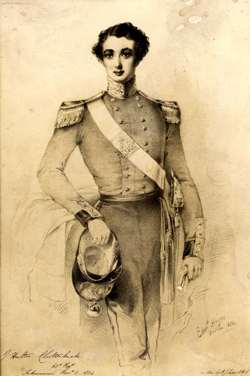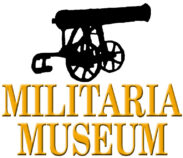From the Museum of the Manchester Regiment website
1854 – 1856
A squabble over jurisdiction within the Holy Places of Turkish ruled Jerusalem brought France into controversy with Russia. Britain took the part of France and the two nations allied themselves with Turkey. Nicholas I of Russia saw an opportunity to dominate Turkey to secure a Russian entrance to the Mediterranean, and a Russian army commenced occupation of Turkish and Rumanian areas.
The allies declared war on Russia in March and so began the Crimean War. In April Austria, after entering into a defensive alliance with Prussia against Russia, massed an army of 50,000 men in Galicia and Transylvania. In face of this threat Russia moved out of the Turkish and Rumanian areas which it had occupied but rejected peace conditions set by Britain, France, Prussia and Austria that Russia must keep its hands off the Ottoman Empire. Britain and France decided that crippling the great naval base at Sevastopol should break Russian power in the Black Sea. An expedition to effect this was decided upon without any real consideration of the task and without any adequate reconnaissance beforehand.
The 63rd, then in Ireland, were twice called upon to send volunteers to other under-strength regiments awaiting embarkation and as a result were themselves considerably under-strength when new Colours were presented to them in Dublin in May 1854. Then, given less than 6 weeks to join the expeditionary force to the Crimea, a large number of recruits were obtained from the young men of Dublin.
Shortly after landing on Russian soil the 63rd was sent to take part in the forthcoming battle at the River Alma, but arrived after a 13-hour forced march too late to take an active part in the battle. Shortly afterwards they went on to Balaclava where the Regiment was present at the mainly cavalry engagement which later became famous as ‘The Charge of The Light Brigade’.
In the early hours of Sunday 5 November 1854 the Russians mounted a large-scale attack against the British 2nd division on Mount Inkerman. The 4th Division, with which the Regiment was serving, was immediately sent there and arrived in time to help in the recapture of the guns of Boothby’s Battery, which had been seized by the advancing Russians. The Regiment had only just returned from night duty in the trenches and everyone was wet and cold. The journey to the scene of action was most uncomfortable and disheartening. It was dark and foggy, with a thick rain falling. On arrival the 63rd joined the 21st Regiment and both were positioned astride the top of the quarry ravine up which the Russians were advancing in great numbers.
The two regiments were ordered to lie down under cover of brushwood until the advancing Russians came sufficiently near. It was then nearly 9am and sufficiently light to enable many thousands of Russian infantry to be seen advancing up the ravine. The crowded Russian columns came under withering fire and, whilst still reeling, were charged by both regiments and driven back in confusion.
This was a day in which the Sergeants of the Regiment had excelled themselves. The Escort to the Colours – Colour Sergeants Francis Avery and James Wooton were both wounded when the young Ensigns had fallen. The Queen’s Colour was rescued in the heat of the battle by Colour Sergeant John Brophey who continued to wave the Colour and cheer the Regiment on until he was wounded in the left thigh. Sergeant Arthur Roberts received a wound, which caused him to fall. He quickly got up, retrieved the Regimental Colour and, refusing to leave the field, continued to carry the Colour until incapacitated by a second wound.
Sergeant William Ahern, learning that Ensign Clutterbuck was killed and that his body was still on the field of battle, instantly volunteered to find it and, with a private soldier, went far in advance and retrieved the body. Earlier on that day, his only officer being wounded, Ahern had taken command of his company and led during the charge. Colour Sergeant William Morris finding himself in the battle far in advance with a number of men, collected them together, took command and drove back a party of advancing Russians
Sergeant Major Slack was later commissioned as Ensign and awarded the French Gold War medal and the 5th class of the Imperial Order of the Medjidie. Colour Sergeants Brophey and Morris, Sergeants James Ward, Robert Hughes, Arthur Roberts and William Ahern were all awarded the French Gold War medal for their bravery that day. Sergeant Christopher Elliot was awarded the French Legion of Honour.
After some months rest the Regiment took part in the siege of Sevastopol, which fell in September after four days hard fighting. The 63rd then took part in an assault landing on the Russian mainland at Kinburn where the capture of the fort and the destruction of Russian supply dumps crowned the operation with success.
Closely following this advantage the Regiment soon came up against a strong Russian position and suffered heavy casualties. However, despite the fact that Lieutenant Colonel Exham Swyney, the commanding officer, and Ensign James Hulton Clutterbuck carrying the Queen’s Colour were both killed, Ensign Heneage Twysden, carrying the Regimental Colour, mortally wounded, the Adjutant and three of the company commanders wounded, the Regiment with the rest of the Division pressed on. By mid-afternoon the Russians had begun to withdraw into Sevastopol. During the battle the 63rd lost three officers and thirteen men killed. Seven officers, nine Sergeants and seventy-four men were wounded. Ensign Twysden died of his wounds two days later.

Ensign Vieth, carrying the Queen’s Colour of the Regiment, jumping out of his assault boat into the water, drove the pike of his colour into the sand letting the colour fly on the breeze. The Queen’s Colour of the 63rd was the first British flag on the soil of Russia proper and this was the last time that the colours of the Regiment were carried in battle.
This was the final action of the war, peace being declared in early 1856. Throughout the campaign the Regiment had fought in every major action and suffered 950 casualties, killed in action, died of wounds or invalided home through wounds or sickness. The battle Honours of ‘ Alma ‘. ‘Inkerman’ and ‘ Sevastopol ‘ were awarded to the 63rd.
Thanks to Tameside Metropolitan Borough Council
